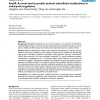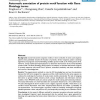3708 search results - page 737 / 742 » The Inverse Classification Problem |
AI
2002
Springer
13 years 7 months ago
2002
Springer
Neural network ensemble is a learning paradigm where many neural networks are jointly used to solve a problem. In this paper, the relationship between the ensemble and its compone...
BMCBI
2004
13 years 7 months ago
2004
Background: Hidden Markov Models (HMMs) have proven very useful in computational biology for such applications as sequence pattern matching, gene-finding, and structure prediction...
BMCBI
2004
13 years 7 months ago
2004
Background: Subcellular localization of a new protein sequence is very important and fruitful for understanding its function. As the number of new genomes has dramatically increas...
BMCBI
2004
13 years 7 months ago
2004
Background: Identifying protein-protein interactions is fundamental for understanding the molecular machinery of the cell. Proteome-wide studies of protein-protein interactions ar...
BMCBI
2004
13 years 7 months ago
2004
Background: Conserved protein sequence motifs are short stretches of amino acid sequence patterns that potentially encode the function of proteins. Several sequence pattern search...


